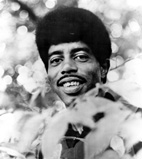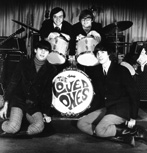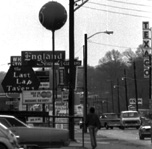




 |
 |
The Scribes of the Strip
From “Cool Cat: Clifford Curry”
by Shannon Stanfield
Clifford Curry keeps his age a secret. As he puts it, “Why does everybody want to know how old I am?” The soul singer remembered for his hit, “She Shot a Hole in My Soul,” got his musical start doo-wopping in high school in Knoxville the 1950s. Curry grew up in a small black neighborhood in Bearden just across the tracks from Lyons View Pike and Cherokee Country Club, the golf and tennis destination for many a wealthy white family in nearby Sequoyah Hills. Though closer to Bearden High than most of the Caucasian kids zoned for the school, Curry was bussed across town to Knoxville’s black school, Austin High. Humming Dominos, Clovers and Oreos songs in the bathrooms of Austin, Curry sang baritone for several doo-wop groups during the school season, caddying and sneaking onto the golf course summer nights at the country club back home.
It was one such autumn night in the mid-1950s that Curry landed what may have been one of Knoxville’s first multi-racial shows. One Friday, after he watched a Bearden football game from outside the fence, some of the boys playing the sock hop afterwards wanted Curry inside and onstage. They had heard tell of the tall, lanky soul singer who lived down the street and asked him to join their band, Dewey Guy and the Fabulous Six, that very night. Curry said he went home to ask his grandmother permission. “It was my first integrated gig,” he recalled.
Back at Austin High, Curry’s doo-wop group, the Echoes, was busy booking shows of their own, landing opening spots with some of their heroes at Chilhowee Park. Joining the likes of Faye Adams, Bill Pinkney and the Drifters, and the Clovers, Curry still had to ask permission to take the bus across town at night. It was at the suggestion of the Clovers that Curry’s group, the Echoes, made a trip up north to audition for the Clovers’ label, Atlantic Records. Stopping first at Savoy Records in New Jersey, the Echoes never made it to the Big Apple. After hearing Curry’s “Mr. Moon,” Savoy owner Herman Lubinsky offered to sign them on the spot as the Five Pennys. After a pow-wow in the car, the Knoxville quintet put pen to paper. Enjoying moderate success with the song, Curry wondered what would have happened if “Mr. Moon” had gotten the push from Atlantic: “We never made it to New York, and that was a big mistake.”
By 1959, he was out of high school and ready to pay some soul-singing dues. With regional touring band Bubba Suggs, Curry found his groove as “Sweet Clifford,” a nickname that stuck for life. Singing the opening set for the road band, Curry traveled the Southeast stealing vibes from headliners like James Brown, Joe Tex, Solomon Burke and Little Willie John. Learning his craft from the best in the world, Curry realized soon enough he needed to make a name for himself if he intended to stay in the music biz.
Returning to Knoxville, Curry hit the Strip, where the soul scene was just starting to catch fire. At clubs like the Pump Room, the Twin Lite and the Place, Curry fronted horn bands filled with college music majors, taking many of them to school with his catalogue of soul standards. All the while, Curry trekked to Nashville to record with an old friend and songwriter, Buzz Casum. One such Casum-produced song, 1967’s “She Shot a Hole in My Soul,” came to define Curry’s career.
Playing bass, trumpet and keyboard for Curry on weekends, Rob Galbreath was also the graveyard-shift DJ at Knoxville’s WNOX-AM every week night 8 p.m. to midnight, where he started spinning soul on regular rotation. Back in the day when a radio station’s power was limited more by its budget than the FCC, WNOX had a signal that pumped all the way from Knoxville, over the Smoky Mountains and right to Myrtle Beach. There, wayward Caucasian college and high-school kids from across the Southeast spent their summer nights, cruising, Shag dancing and falling in love—many to the hot single. The record’s B-side, “We’re Going to Hate Ourselves in the  Morning,” also became a frat and sorority sing-along standard. It wasn’t long before Curry received a call from Cecil Corbit’s Myrtle Beach “Beach Club” and immediately quit his day job selling shoes at downtown Knoxville’s United General Products. By the time vacationing kids were back at college, Curry was a must-have on the frat-party circuit. Booked by Charlotte’s Theater Attractions, Curry hit the road, driving himself and fronting pick-up bands across the Southeast. Morning,” also became a frat and sorority sing-along standard. It wasn’t long before Curry received a call from Cecil Corbit’s Myrtle Beach “Beach Club” and immediately quit his day job selling shoes at downtown Knoxville’s United General Products. By the time vacationing kids were back at college, Curry was a must-have on the frat-party circuit. Booked by Charlotte’s Theater Attractions, Curry hit the road, driving himself and fronting pick-up bands across the Southeast.
Holding court for generations of frat boys across the South, Curry based himself in Nashville in the 1970s, still working with Casum, searching for the next Curry hit. By the late ’70s, Curry’s career rebounded as Animal House was released and many a Bluto-like frat daddy would Gator the night away rolling in puddles of sour beer as Curry conducted behind the microphone: “I think y’all gonna Gator now; I think a lady’s gonna Gator!” Pushing his hit along with standards like “Stagger Lee,” “Shout,” and “Shamma Lamma Ding Dong,” convinced some that Curry must have been the model of Animal House’s fictional, pompadoured, soul-wailing, Otis Day and the Nights.
By the early ’80s, many of Curry’s fans had matured right along with the singer, taking their cherished Shag dancing memories along with them to another level. With Shag dancing becoming less a party and more an organized recreation with conventions, a hall of fame and even a movie, Shag, the dancers were able to encapsulate their memories offering a comeback audience for Curry. In 1981, in demand at Myrtle Beach even more than before, Curry scored again with “(Baby Won’t You) Shag With Me” and “Let’s Have a Party,” both co-written with his old friend Rob Galbreath.
In the ’90s, attaining a somewhat long-term band (by Curry’s standards) filled with Nashville cats, Curry hit the road for one-nighters, touring Europe every other year or so. When he wasn’t flying to Europe, he was flying to some of his former frat friends’ private parties where he would again front whatever soul band was available that night, sell some T-shirts and CDs after the show and hop the red-eye back to Nashville. Besides a place to record (Curry lives across the street from Casum’s studio), Music City offered a gargantuan pack of oldies stars from the 1950s on. Finding a haven on this oldies circuit, Curry became the show-closer for many of these all-star performances....
Though a generation and a half apart, Curry and I grew up with only a golf course separating our neighborhoods. When he saw the vintage golf clubs in my garage, he remembered carrying them for my grandfather. A personal veteran of the punk-rock scene of the ’80s, I was floored when I first saw Curry singing to a “souled” out room of first-generation boomers at a North Knoxville lounge, watching him direct a controlled chaos of folks jumping onstage, grabbing microphones, grabbing Curry and just wanting to touch his tux as he walked by. Many players hailed as one-hit wonders look back at their 15 minutes with glee, but those in the biz who know Curry would say he expected his next “She Shot a Hole in My Soul” right around the corner. Maybe that is why he never lost his voice, drive or charisma. I’ve never seen a show where he didn’t start at least one song with, “Hey, grab your girl and let’s go back to Cumberland Avenue with this one!”
From “The Place is The Place”
by Terry Johnson
What a hellish thing to have long hair in K-town in the mid-’60s. There were five of us: the Loved Ones and Jesus. We were actually physically attacked on several occasions (“Do yew boys squat to pee?”) and run off the road at least twice. Byrd capped off the era perfectly late in 1966, when we were getting well known. We were in the Krystal on Broadway when a guy saunters up, hoists up his britches, and says, “Ain’t yew boys the Loved Ones?” Byrd replied, “No, man, we’re queers.”
They say if you can remember the ’60s, you weren’t there. But I do, even though I often can’t remember what I had for lunch.
Barry “Byrd” Burton and I learned guitar together. Actually ukuleles at first, since neither of us could afford a real guitar. I had been playing piano with a band called the Cyclones since I was about 12, and Byrd was doing a duo with a guy named Clyde Wilder. They actually did a live radio thing for a time on WRGS in Rogersville, so we were sort of mutual admirers and eventually got together about 1961. We soon wrangled some electric guitars out of our parents: a Kay “Value Leader” for Byrd, and a Kay “Speed Demon” for me. They had neither value nor speed, but they were loud, which was what we wanted. Our first gig was a Christmas party in 1962 for $15 each. We had struck the motherlode: people would actually pay us for playing! By 1963, we had scraped up enough to buy a Stratocaster and a Jazzmaster, just like the Ventures, and even a couple of old Fender amps.
Late in ’63, we joined up with Ed Hagood, an old childhood friend of mine who actually owned and played a set of drums. This was a rare thing in East Tennessee at that time. I still have a ledger book of our gigs showing a 26-week stint as house band at the Thunderbird Lounge in Newport, a place to which you would not wish to take your mother unless she packed a .357-Magnum. (There was a small door through which the owner would loose a big German Shepherd on the crowd during bar fights.) Bassist Doug Graham was in the band, by then called Terry and the Casuals, as was a keyboard player named Ralph Wooten, who had a brand new B-3 and a Leslie. Life was good, and we actually had a few early fans. The summer of ’64 was a watershed. Things were never that simple again. a place to which you would not wish to take your mother unless she packed a .357-Magnum. (There was a small door through which the owner would loose a big German Shepherd on the crowd during bar fights.) Bassist Doug Graham was in the band, by then called Terry and the Casuals, as was a keyboard player named Ralph Wooten, who had a brand new B-3 and a Leslie. Life was good, and we actually had a few early fans. The summer of ’64 was a watershed. Things were never that simple again.
Doug and I enrolled at UT in the fall of ’64 while Byrd went off to Hiwassee College on a basketball scholarship. We were miserable, though our GPAs were perfect: triple zero. I spent the fall quarter teaching Doug bass guitar in lieu of the old Fender Rhodes Piano Bass, and we would visit Byrd and jam in his dorm. We knew something had to give, and by the fall of 1965, Byrd came to UT, and the band rented an underground apartment affectionately called 412, which the landlord said was also known as the Mayflower Apartment, because so many girls came across there. Maybe a few—free love was a couple of years away—but we were interested primarily in the music. It was here that the Loved Ones became a real band. We auditioned some drummers from UT, and chose Mike Coyner, who was the loudest drummer I ever played with, using what looked like logs for drumsticks. It was a rare gig that he didn’t change a snare drumhead....
Being primarily a cover band, we learned every nuance to every song (a dubious practice long-term, but it was part of our growth). We would argue for days about a chord voicing. I remember learning the Critters’ “Mr. Dyingly Sad” took four 16-hour days. But we were playing every weekend, and more, and had found the life we imagined. At one of these early gigs, we were approached by Bill Baillee, who, happily for Doug and me, worked at a package store.... We needed a new name for our first recording, “I Love Her More,” recorded at Jim Clayton’s home studio on an Ampex reel-to-reel. WKGN played the heck out of it, billing us as the “WKGN Wonder Who,” and asking listeners to send in suggestions for a name. The somewhat dubious winner was “the Bloques,” but it was either that or “Sneaky Snake,” the second choice. The name lasted less than a year. We bought a 1941 Cadillac limo, dubbed it the “Bloqueswagen,” and were on our way. As far as I know, “I Love Her More” did not survive, since it was only available in acetate.... We were covering the entire Southeast by early 1966 and effectively dropped out of school.
In 1966, we went to Nashville to record at Bradley’s Barn, which produced “Surprise, Surprise,” “Another Time or Place,” and “Love the Girl.” We actually had a record label, Ambassador, which released the first two on a single, which “bubbled under” for a summer but never quite made the charts, as far as I know. I did hear it a lot on the air: Atlanta, Louisville, D.C., and Knoxville, of course. We also did another session at the Barn, but the songs are lost. That spring, the Place (on the site of what’s now O’Charley’s), which would become our unofficial headquarters, opened. I remember helping decorate the inside, painting, setting up the bandstand, and so on. Before the grand opening, Alan Copeland, who was our drummer at the time, painted the Day-glo psychedelic images on the walls. The Bloques, since renamed the Loved Ones, opened the club. I remember also Toby Lees and Steve Hostak, the Perfect Strangers, played during breaks. Sparky Rucker played a few blues tunes with us from time to time. I believe the Knight Riders, a good rock band from Oak Ridge, did some shows there as well.
The Place was the “mod” hangout, a sort of no-man’s land between the British Invasion and the R&B status quo. Most of the acts there were British, hard rock, or psychedelic, at least in the beginning. We always kept tabs on the R&B guys, though, especially Little Joe and the Apollos, Sweet William and the Stereos, and Clifford Curry. If we were at one frat house on Saturday night, they were at the next one, and we always looked in on each other during breaks.... Around this time, WTVK-TV began running Dr. Al’s Disco-Teen Show, which was a sort of live precursor to the modern music video. I remember sweating in ersatz leather pants under the TV lights with my best John Lennon scowl, lip-synching “Surprise, Surprise.” ... Also along the Strip, I remember the Pump Room, which soon burned, Ballis’ Pool Hall, and, of course, Sam and Andy’s. Many times, I ran up to the Vol Market for a slaw dog between sets at the Place. In earlier, leaner years, a guy named Cecil at the Toddle House would give us all the pies from the day before, which kept us from starving. We also played the Twin Lite on the north side of Cumberland, almost to Henley St., but the Place was the place. The summers of 1966 and 1967 were spent in New York. After deciding not to sign a contract with Roulette Records, I left the band and came back to Knoxville to await the birth of my first child. A wise man once told me, “You can do music, women, or sports. Pick one.” Truer words were never spoken.
I think the ’60s are best summed up by a quote from the liner notes of our current group, the B-Team Blues Band’s first CD: “We paid our dues, but forgot to get a receipt.”
[Ed. note: Doug Graham, longtime bassist for the Loved Ones, died unexpectedly this summer as the band was preparing for this reunion show. Ranse Whitworth, another sometime bass player for the Loved Ones, will take Graham’s place in Saturday’s show.]
From “Cumberland Ave.: A Great Place to (Never) Grow Up”
by Emily Jones
Cumberland Ave. from 1970 to 1980 was the center of the universe for folks who loved music and dancing in a culture outside the country club scene.
The first time I ever went to Cumberland was to hear some band at the Place playing covers from the Rolling Stones’ Sticky Fingers album. The backlights, strobes, and dance floor were much more exciting than the Sadie Hawkins Dance at the Holston High School gym. I loved it, and spent the rest of my high school and college nights dancing to some of the greatest music in the Southeast....
We lived in the suburbs but grew up on the Strip. On Friday or Saturday, my friend Laurie and I would find a way to get to Cumberland Avenue—we weren’t old enough to drive. We would make the rounds, buy bubble gum, Mr. Natural posters, and comic books at the Hydraulic Lift, visit Patrick at the Odyssey, buy new jeans or a peasant blouse at Bell Bottom Blues, play some  pinball, get a hot dog and Dr. Pepper at the Vol Market and wait for the music to start. Sometimes, there would be a Jacaranda concert at Tyson Park, or Cowcatcher would be playing at the Tunnel. We knew everybody at the door. Danny Barker would always let us in if he was working. We didn’t have any concept of fake IDs or how we were going to get home. We were there for the music and always got back safely with a little help from our friends. pinball, get a hot dog and Dr. Pepper at the Vol Market and wait for the music to start. Sometimes, there would be a Jacaranda concert at Tyson Park, or Cowcatcher would be playing at the Tunnel. We knew everybody at the door. Danny Barker would always let us in if he was working. We didn’t have any concept of fake IDs or how we were going to get home. We were there for the music and always got back safely with a little help from our friends.
Eventually, we made our way east on Cumberland Ave., from the Place and the Tunnel (where Fatback and Beaucoup Dap, two early versions of the Amazing Rhythm Aces played) to La Cantina, Foxy Lady and the apex of Knoxville rock ’n’ roll, Bradley Station. Jim Bradley ran the hottest club in Knoxville. No doubt about it. He brought in bands from Atlanta and featured local talent as well, including Rich Mountain Tower. They were the best. Dana Paul and Sandy Garrett were excellent songwriters, and the music was about this place—East Tennessee, the mountains, our lives.
Jeans were tight and platform shoes were high. We survived high school, entered UT and became rock ’n’ roll queens. Music changed; everybody learned to “Do the Bump.” After the Bradley’s closed at 2 a.m., we headed to the Carousel Club for disco dancing and drag shows. Tony Carlisle, Jamie Chambers, and a host of other entertainers put on elaborate shows with great costumes, humor and panache....
Through the late ’70s and into the early ’80s, music became political again: Concerts to register voters to elect Bill Nolan and Bill Owen; historic preservation in Fort Sanders; the Laurel Theater; the Longstreet Journal. As we entered the ’80s, Cumberland Ave. morphed into a music venue the whole city would come to—the 1982 World’s Fair—and as always, the music was great.
From “Pushing a Broom”
by RB Morris
When Jerry Britt asked me to give him a hand getting the Longbranch Saloon open one day, I became the janitor. It was as if I had retired. On appearance, it was rather embarrassing.  I had been around the scene for some time playing music, and all of a sudden I’m pushing a broom and mopping up after everybody’s mess in a local dive. I didn’t even want to work the relatively cool position of bartender, as Jerry asked me to do. I thought I would write the great American novel from a janitor’s point-of-view, and kept a typewriter at the end of the bar. I fell back to hanging out and being a spy on the scene. I felt removed and apart, but I was probably more into the scene than ever before. I had been around the scene for some time playing music, and all of a sudden I’m pushing a broom and mopping up after everybody’s mess in a local dive. I didn’t even want to work the relatively cool position of bartender, as Jerry asked me to do. I thought I would write the great American novel from a janitor’s point-of-view, and kept a typewriter at the end of the bar. I fell back to hanging out and being a spy on the scene. I felt removed and apart, but I was probably more into the scene than ever before.
The idea was to have the best little neighborhood bar and venue for live music around. Eventually, we would tear out the wall that divided the backroom and make it one large room with a bigger stage at the rear.
In a way, this sort of divided the music history of the Longbranch Saloon. The Longbranch originally had the stage up near the front door, and the music was immediate and on the street. It had a good-sized front room with a long bar. The back room was divided, with pool tables on one side and booths and tables on the other. That was probably the musical heyday of the ’Branch. I sang an occasional song with bands when the stage was up front. In the meantime, Stuart Wright (first with the Tower then with his band) started covering some of my songs: “Listen To Me Louise,” “Roy,” “Me and My Wife Ruth.” The Amazing Rhythm Aces covered one of his songs, “If I Just Knew What To Say,” on their second album, the album that won a Grammy....
From “Rock ’n’ Roll Deli”
by Rus Harper
In the spring of 1984, I had no idea what was involved in putting on even a very small rock show.... One night, Todd “Bonehead” Townsend and I went prowling the Strip, looking for prospective venues. I wanted to find a place that would take on Neon Christ and a couple of local bands, Dissocial and the STDs. Finally, we went into Vic ’n’ Bill’s on the Strip to look around. It used to be the Place, and they had some pretty decent rock shows there.... They had put in a deli at the front of the building, but there was still a good-sized room beyond that, with a bar and a 6-inch stage at the back. Perfect. I talked to Vic first, because he was  working at the bar. I told him about how he could let me book a show there and bring in people who would buy a lot more beers than I would. He thought a minute or two and offered me a whole weekend. Damn!.... It snowballed.... Dennis “Doc Shock” Shockley helped work the door. He had a hollow plastic rabbit with a detachable head he called “the money bunny.” Camp Childers, guitarist for the STDs and serious rock fan, brought in bands we never dreamed would play in a deli in Knoxville. Black Flag, Dead Kennedys, Circle Jerks, 45 Grave, Minutemen, Channel 3, Suicidal Tendencies, Scream, Jody Foster’s Army, Marginal Man, TSOL and the Descendents all played at the rock ’n’ roll deli, most giving Knoxville musicians a chance to play shows with bands they listened to and loved. working at the bar. I told him about how he could let me book a show there and bring in people who would buy a lot more beers than I would. He thought a minute or two and offered me a whole weekend. Damn!.... It snowballed.... Dennis “Doc Shock” Shockley helped work the door. He had a hollow plastic rabbit with a detachable head he called “the money bunny.” Camp Childers, guitarist for the STDs and serious rock fan, brought in bands we never dreamed would play in a deli in Knoxville. Black Flag, Dead Kennedys, Circle Jerks, 45 Grave, Minutemen, Channel 3, Suicidal Tendencies, Scream, Jody Foster’s Army, Marginal Man, TSOL and the Descendents all played at the rock ’n’ roll deli, most giving Knoxville musicians a chance to play shows with bands they listened to and loved.
From “Various Exploding Drummers”
by Scott Campbell
I first heard about some wild rockabilly band led by Preston Rumbaugh, the Blue Rockers, playing on the Strip from some people at a party who had seen them. They had a blast, danced their asses off, and said it was the real deal. I started sitting in with them, and pretty soon I was in the band. We played all the regular Strip bars and had a big weekly gig at the Best Italian. We actually played the night it burned down. I guess we were really hot that night.
We all lived at the Trestle Package Store for a while. It belonged to the bass player’s father-in-law and had a big apartment upstairs. The bass player’s name was Jeff Courtney, but we all called him Chawdaddy. He and drummer Bobby Alexander knew each other growing up in Richmond. Bobby had a pet chicken with a giant foot. Seriously, this thing looked like it was bitten by a Tsetse fly. We all worked there, and we would practice while the beer store was open. There was a sitting area behind the cash register where the band would set up, and Preston would give me a solo while he turned around and rang up the customers’ purchases.
From “Chico, The Man”
by Jim Williams
I met keyboardist extraordinaire Chico Crawford through Con Hunley’s bass player, Jon Schwabe, back around the time Hector Qirko’s band started in the mid-’80s. Jon had just left Con’s band and joined a new group called Daddy-O. Eddie Davidson was playing drums; Tom Norris, guitar; Schwabe, bass; Erin Davidson sang and played the fiddle; and Chico was playing his Hammond B-3 organ, which he somehow could load in his van by himself. These were all monster players. Eddie had studied at Berklee; Jon had started at UT.
After Joel Fairstein left the Hector Qirko Band, I called Chico. Chico played with us for a year or so. He left and joined the Blues Merchants when they formed with guitarist “Detroit” Dave Meer, saxophonist Scott Campbell and others. I played with him on and off ever since, most of the time with “Detroit,” and usually featuring Hal Hardy as the primary vocalist, doing blues and funk stuff. Some of those bands were really, really good. Although we did a bit of work out of town, the birthday parties for East Knoxville character Fred Logan were the highlights of the time; that was always an adventure. Always a party with Chico. He loved to see the girls dance and knew how to make it happen....
Editor’s Note: “Detroit” was with one of the original incarnations of Crawford’s well-known early ’80s group, Chico and the Men, which played the Strip, the Porch and other places. Ivory-tickler-crooner and regional country star Con “Oh, Girl” Hunley was the house act at the Corner Lounge on Central Avenue for many years.
From “This Town Will Be Killed By Apathy: In Search of the Short-Lived ‘Knoxville Sound’”
by Coury Turczyn
From the late ’80s till the mid-’90s, there was an identifiable “Knoxville sound” of jangly garage rock that stood out from the disparate sounds of the local music scene. It was singularly funny, unpretentious and emotionally revealing even as it rocked in a pop-friendly way. It never got much airplay and wasn’t big enough to put Knoxville on the hype map as an official music mecca like Austin or Seattle, but it was its own cool thing, destined to remain Knoxville’s and Knoxville’s alone. hype map as an official music mecca like Austin or Seattle, but it was its own cool thing, destined to remain Knoxville’s and Knoxville’s alone.
The sound emanated first from the boys in Smokin’ Dave: Dug Meech on drums, Dave Nichols on bass, and Todd Steed with vocals, guitar, and—most importantly—songwriting and attitude... And Smokin’ Dave and the Premo Dopes was about, in large part, being a Knoxville band. To this day, there is a certain amount of embarrassment attached to that label. Knoxville is not known nationally as a music town, and local bands usually want to get away as soon as possible. But Steed did not equate staying in town and playing dives as failure. Instead, that’s exactly what he wanted to do.
By the late ’80s/early ’90s, this radical way of thinking infected other up-and-coming bands whose songwriters also shared a similar sense of humor (and who coincidentally hung out with Steed a lot). Laffs and rock ‘n’ roll typically don’t mix—either a song is funny or it rocks. But these Knoxville bands somehow made this forbidden fusion work, just like the Dopes.
From “She-Ra Strikes Back”
by Shelley Ridenour
The funny thing is, while all this was going on, everyone was grousing about Knoxville’s lack of a scene. It was only after I moved to New York—where high rents mean far-flung practice spaces and thousands of bars mean no one is ever in the same place at the same time—that I realized the incredible community Knoxville had.
In a weird way, lack of opportunity makes a scene; not having a fistful of international bands to choose from on any given night brought us together. I miss the fact that, if I didn’t have anything to do on a Friday night, I could go to the Longbranch and always have someone to hang out with. I miss knowing that I could go to a show and run into everyone I wanted to see. I miss Knoxville, assholes and all.
[Ed. note: Several of the performers described above, including Clifford Curry, the Loved Ones, and Chico Crawford, will be playing at MetroFest, this Saturday on Market Square.]

September 9, 2004 • Vol. 14, No. 37
© 2004 Metro Pulse
|
|